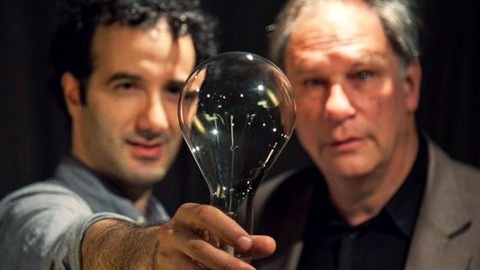Radiolab Part I: The Strategy of an Aesthetic
We tend to settle into an experience and get the most out of it when the expression of that experience doesn't get in our face about what the experience is all about. A hot tub would be far less fun, for instance, if instead of getting our feet wet the experience began with an alarmingly hot bucket of water being dropped on our head; especially if there was also a voice on an intercom yelling, "You're too tense! Relax! Relax!"
Radiolab is a radio program and podcast hosted by Jad Abumrad and Robert Krulwich. It’s easily one of the best, and that’s a huge endorsement now that there are so many excellent podcasts. Radiolab is so good Ira Glass, the celebrated host of the radio program and podcast This American Life, experiences jealousy and marvel in response to their work.
As Glass points out, Radiolab uses an original aesthetic to convey their messages with the ultimate effect being an immediate, intimate connection that science shows and broadcast journalism generally have had a hard time accomplishing. Science shows in particular fall into conventions that can come across as too lecture-like and corny.
So how is the Radiolab aesthetic and connection achieved? One general approach is similar to the increasingly organic, more helpful and more appreciated integration of marketing into our lives. Just as some of the best experiential marketing isn’t an interruptive banner ad featuring more brand name than anything else, Radiolab doesn’t hit us over the head with the fact that it’s a show about science. Radiolab’s tone captures an audience that feels the tone of public radio is generally too affected.
Certain brands capture audiences incongruous ways. Dove, for instance, in the ad below, captures an audience that feels health and beauty brands will tend to exploit consumers’ insecurities. For six and a half minutes no one says, “Dove;” we only see the word and logo at the end for six seconds. We’re not hit over the head with the fact that it’s an ad for something you can buy at all. None of Dove’s products make an appearance. Instead, it’s Dove’s empowering message about self-image that takes center stage.
In a similar vein, Cheverlot paired up with the band OK Go to create a viewing experience so spectacular you don’t even have to like OK Go or Cheverlot to enjoy it. In fact, if you don’t know who OK Go is and you don’t know the Chevy logo you won’t even realize the band and the car company are doing a cross-promotion. No one says, “Chevy,” the name isn't written anywhere at all and nearly four minutes go by before we see a few shots of the logo at the end for twelve seconds. We’re not hit over the head with the fact that it’s an ad about a car. Instead, we’re treated to a few minutes of fun.
To the extent that creating an aesthetic is a matter of making a set of integrated choices that connect with an audience the process of creating an aesthetic is akin to the strategy that ties together advertising campaigns.
Today more than ever advertising applies the techniques of its aesthetic cousins. A characteristic of the “family resemblance” of these expressions is how regularly mediums are redefined and refreshed. Advertising is more explicitly a means to an end than other artistic expressions; but it seems we’re learning more and more that the ends at stake for marketing are far beyond the scope of sales. A sales department should bend towards the product and drive relevant availability. A marketing department should bend towards markets and drive demand by addressing consumer needs.
As Radiolab shows us, addressing those needs requires an artful response to the call of an audience. Just as the best art inspires more art, the best listening inspires more listening. Sometimes that listening means learning about science. And sometimes that listening means learning about a brand. In either case, this kind of learning is an extension of a deeper, visceral experience with its roots in gratitude; gratitude not only for the learning experience but also for the way the experience is made enjoyable and resonant.
We continue to expand what it means for advertising to be considered successful. Persuasion isn’t the only goal. The long-term value of persuasion depends on the amount of gratitude that can be concurrently inspired on a regular basis. That’s the road to marvel.
You can check out Part II of this article to learn specific details about how Radiolab’s tone is created and how advertisers inspire marvel when they make similar choices.

Comments
Post a Comment